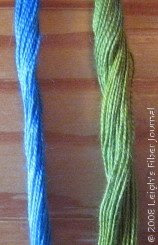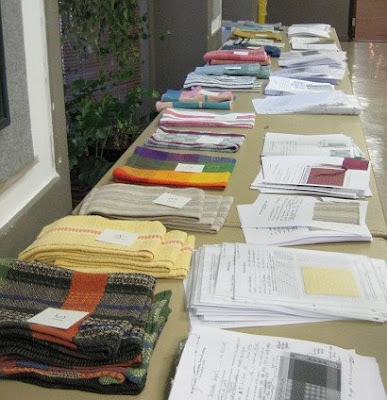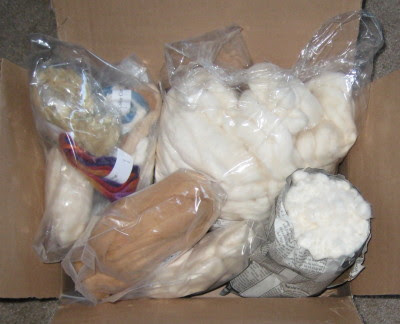
At last I have
conquered this warp
and am finally having fun!
 The particulars:
The particulars:
~ Warp & weft: 20/2 mercerized cotton
~ Warp length: 3 yards~ Woven length: 8.5 inches per bookmark
~ Sett: 105 epi
~ Reed: 15 dents/inch (7 ends/dent)
~ Total ends: 292
~ Width in reed: 2.75 inches
~ PPI: 24
~ Weave structure: Warp-faced plain weave
~ Stripes: painted & ikat
Since this is plain weave, weaving is super fast! The bookmarks will be fringed, and you can see in the photo on the left that I'm using card stock in between each bookmark to allow for that.
For the weft, I'm using the same black that I used at the edges. This way the weft thread isn't noticeable at the selvedges.
Also, I'm using a stick shuttle, which has come in very handy. Since the warp is packed so closely together, the threads tend to stick together when I treadle. I'm finding that this shuttle is a great way to open up the shed . . .
 . . . before throwing the next shot .
. . . before throwing the next shot .I did have one "duh" however. The horizontal stripes at the edges are created by threading the heddles with black and white alternately. But notice in the photo below . . .

. . . that on the left, the white warp is on the top, while on the right, it's
the black. This doesn't effect the horizontal stripes any, but it would be
distracting at the fringe. This happened because I didn't pay attention to
thread the odd and even shafts with the same color on both sides! I ended up
unweaving this bit and rethreading the black and white warp on the left side.
Once all the blacks were on odd shafts and the white on even, the two sides
looked the same.
I don't anticipate that finishing up this warp will take very long. I should be on to the next project after the weekend.
[UPDATE 12/02/08: To see the finished bookmarks, click here.]
Related Posts:
I don't anticipate that finishing up this warp will take very long. I should be on to the next project after the weekend.
[UPDATE 12/02/08: To see the finished bookmarks, click here.]
© 29 Nov. 2008 at
http://leighsfiberjournal.blogspot.com
Related Posts:


































